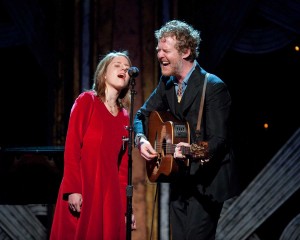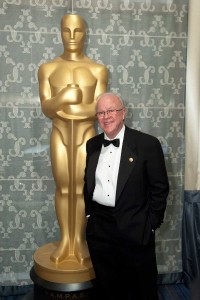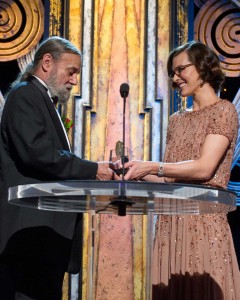
The Scientific and Technical Achievement Awards were presented at the Oscars – over the radio, and later, of course, TV broadcasts – right up until until 1974. Since then, they’ve been awarded at a separate press conference, dinner and cocktail reception of their own, about two weeks prior to the main event, which is viewed by the public as a highlight reel during the Oscar telecast.
The new formula mandates an attractive actress, perhaps with some connection to “tech,” to serve as hostess (and to anchor the highlights later on Oscar night), and this year, it was Fifth Element and Resident Evil star Milla Jovovich, who wore not only an understated evening gown, but commenced hosting wearing a pair of glasses that gave her a kind of “Marian-the-Librarian” vibe, in complete contrast to her modeling life, or, say, Fergie’s arrival the next night at the Grammys.
Whether it was a semiotic signal that nerdom is indeed cool in a technologically-saturated age, or simply a way to read the B&W teleprompter at the back of the Beverly Wilshire’s ballroom, one couldn’t say, nor did one need to worry much about the distinction on what turned out to be a pleasant evening marked by a recurring theme of loss.
There were nice moments of recent Oscar history to start with, in the form of musical openers Glen Hansard and Marketa Irglova, who won an Oscar for best song in 2007 for the song “Falling Slowly” from the indie film Once. Perhaps its lyric, “it’s time that you won,” provides a motif for recognition in the sci-tech honors.
Though the other theme, the one of loss, was there too, as Hansard dedicated a verse of one song “to Whitney,” and “Falling Slowly” itself to slain publicist Ronni Chasen.

But two of the night’s honorees had also passed away before making it to the Sci-Tech stage, including John Lowry, whose eponymous “Lowry Process” helps reduce noise and other artifacts when processing film images – or remastering them – by predicting where pixels should be. Clips were shown of the effect on canonical movies like Rashomon, Dumbo and the original Star Wars film, A New Hope. In the touching acceptance of the award by his colleagues and widow, it was said Lowry was now in a place where “all the pixels are perfect.”
The other was Dr. Jurgen Noffke, who, along with Uwe Weber, helped design a Zeiss Master Prime Lens that achieved a full speed stop advance compared to other lenses while keeping crisp optical quality intact. There was a moment of silence observed for Noffke during the acceptance.
There was a palpable sense of appreciation and gratitude that marked the night, including with the evening’s last two honorees, such as visual and special effects pioneer Douglas Trumbull – fresh off an honor at the Visual Effects Society last week – who received the Gordon E. Sawyer Award for an individual “whose technological contributions have brought credit to the industry.” He mentioned Lowry, too, saying he was “counting on John.” He also mentioned the 120 fps process he’d referred to – still in its tinkering stages at VES, and alluded to the future that everyone figures is coming. “I’m trying to figure out a way,” he said, “to make a movie you are in, rather than working at.”
But that precipice between past and future was probably caught best by the honoree that preceded Trumbull, VFX guru Jonathan Erland, who received the John A. Bonner Medal for “upholding the high standards of the Academy of Motion Picture Arts and Sciences.”
In the evening’s longest speech – whose buzz spilled into the lobby when the show was over – he talked about establishing a “commonweal” for film business nonprofits, part of his view that Academy members should view themselves as “Academicians,” there to promote the future and craft of the art.
(Click here for Jonathan Erland’s John A. Bonner Medal acceptance speech).

Among the initiatives suggested by Erland was the establishment of a science branch of the Academy itself (which may be inevitable as more and more of the pre- and postproduction disciplines become aspects of rendering, all of it headed towards Trumbull’s prognosticated future immersive experiences). Whether this would mean the Sci-Tech awards themselves would return to the Oscar broadcast, he didn’t say.
In another immediately quoted remark, he took to task those who said the Academy needed to cater to younger tastes, or flavors-of-the-moment, noting that if the Academy can’t espouse a maturation of the filmmaking craft, then “what the hell is left for them to grow up for?”
That’s a larger existential question, of course, as Erland seemed to suggest, when he mentioned the Chinese curse of living in interesting times. He noted we’d blown past that marker “all the way to white-knuckle fascinating.”
Whether a matured Hollywood can chronicle some of that white-knuckle fascination, in addition to the large tentpole films it currently favors, remains to be seen.
Either way, though, the innovation in delivering those sounds and images to audiences will continue. And so will sci-tech’s spirited, almost-cozy counterpoint to Oscar evening itself.





